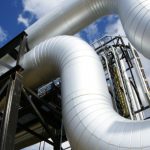
ROCK WOOL PROPERTIES
ROCK WOOL PROPERTIES
ROCK WOOL. Properties. Thermal conductivity. The thermal conductivity factor (λ-value) depends on the temperature. Rock wool has good thermal insulation properties, which do not disappear even when exposed to fire. The drop in temperature in rock wool in cases of extreme temperature is significant enough to prevent material and construction elements on the other side of the rock wool from the ignition.
Heat effect
As stated above, rock wool can withstand temperatures over 1000°C, while the binder is lost from the material starting at 250°C. In an area where the temperature exceeds 250°C, the binder evaporates. The evaporation of the binder does not ruin the structure of the rock wool, because its consistency and layers keep the fibers together. Thus, the material retains its rigidity and protects insulated constructions from fire. As the fibers of thermal insulation material are very resistant to temperature changes, rock wool can be used even with very high working temperatures. The only condition is that the thermal insulation material is installed properly, so the mechanical pressure would not change the shape of the thermal insulation layer while the binder evaporates. The only condition is that the thermal insulation material is installed properly, so the mechanical pressure would not change the shape of the thermal insulation layer while the binder evaporates. In terms of fire resistance, rock wool belongs to the safest A1 class.
Acoustic properties
Rock wool consists of intertwined diabase stone fibers, between which are air gaps. A material with such structure absorbs sound waves especially well: it isolates efficiently both sound traveling by air and impact noises transferred via partitions and ceilings. Airborne sound isolation factor R’w (dB) characterizes the ability of interim constructions to absorb airborne sound. The greater the value, the less noise that pervades the construction. Impact sound isolation factor LVv (dB) characterizes the ability of bulkhead ceilings between the floors to reduce noise, which is caused by walking on the bulkhead or knocking on it, for instance, in the room below. The lesser the bulkhead coefficient L’n,w, the better the construction isolates impact
sound.
Water resistance and vapour permeability
It is well known that moisture within an insulation material deteriorates its insulation properties. Rock wool that has been in the rain may look wet but is actually waterlogged only a few millimeters from its surface. Despite its porosity, impregnated rock wool does not absorb water. In case water is forced into the rock wool, it is absorbed to some extent, but as soon as the water pressure drops, the water evaporates and the material is once again dry, restoring its initial insulation properties. Most polymer insulation materials permeate water vapour quite poorly due to their internal structure. Thus, bulkheads insulated with these materials have high vapour control and if the rooms are insufficiently ventilated, the building may accumulate moisture. Rock wool permeates water (its vapour control factor is the same as that of air). Thanks to this, buildings insulated with rock wool “breathe” and their interiors have a good microclimate.
Ecological factor
Rock wool is an ecological choice because our insulation is made from natural stone. In addition, insulation is one of the few industrial products which helps to save more energy than it requires. In 50 years, a typical insulation product may help to save 100 times more primary energy than was used in its production, transportation, and utilization. Less fossil fuel is used to heat our houses and job sites, thus less pollution is emitted into the atmosphere: CO2, SO2, and NOx. The energy balance becomes positive 5 months after installing the insulation. If the product is used to insulate heating pipes, the energy may pay off in less than 24 hours: the energetic reduction of invested energy is more than ten thousand times greater.



